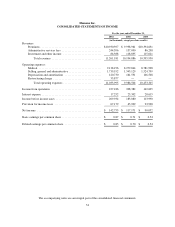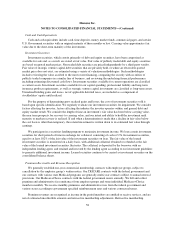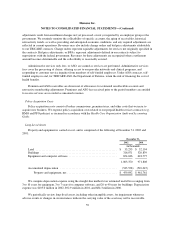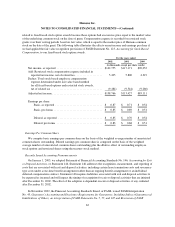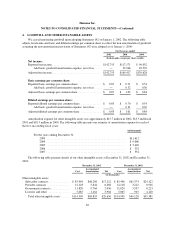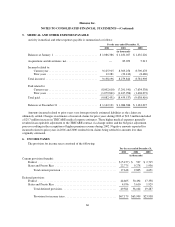Humana 2002 Annual Report Download - page 67
Download and view the complete annual report
Please find page 67 of the 2002 Humana annual report below. You can navigate through the pages in the report by either clicking on the pages listed below, or by using the keyword search tool below to find specific information within the annual report.Humana Inc.
NOTES TO CONSOLIDATED FINANCIAL STATEMENTS—(Continued)
liabilities at December 31, 2002 and 2001. Because the majority of our member contracts renew annually, we do
not anticipate recording a premium deficiency liability, except when unanticipated adverse events or changes in
circumstances indicate otherwise.
We believe our medical and other expenses payable are adequate to cover future claims payments required.
However, such estimates are based on knowledge of current events and anticipated future events. Therefore, the
actual liability could differ from the amounts provided.
Book Overdraft
Under our cash management system, checks issued but not presented to banks frequently result in overdraft
balances for accounting purposes and are classified as a current liability in the consolidated balance sheets.
Income Taxes
We recognize an asset or liability for the deferred tax consequences of temporary differences between the
tax bases of assets or liabilities and their reported amounts in the financial statements. These temporary
differences will result in taxable or deductible amounts in future years when the reported amounts of the assets or
liabilities are recovered or settled. We also recognize the future tax benefits such as net operating and capital loss
carryforwards as deferred tax assets. A valuation allowance is provided against these deferred tax assets if it is
more likely than not that some portion or all of the deferred tax assets will not be realized. Future years tax
expense may be increased or decreased by adjustments to the valuation allowance or to the estimated accrual for
income taxes.
Professional Liability Risk
We bear general business risks associated with operating our company such as professional and general
liability, employee workers’ compensation, and officer and director errors and omissions risks. Professional and
general liability risks may include, for example, medical malpractice claims and disputes with members
regarding benefit coverage. We retain these risks through our wholly-owned, consolidated insurance subsidiary.
We reduce exposure to our own general business risks by insuring levels of coverage for losses in excess of our
retained limits with a number of third party insurance companies. We remain liable in the event these insurance
companies are unable to pay their portion of the losses. In an effort to minimize credit risk, we insure our risks
with a number of insurance companies having a long history of strong financial ratings.
We accrue for professional liability claims reported and outstanding and an estimate of claims incurred but
not reported (based on actuarial determinations using past experience, modified for current trends) and
corresponding loss adjustment expenses incurred to adjudicate such claims. We continually review these
estimated liabilities, and make necessary adjustments as warranted. Given the nature and degree of uncertainty
involved in projecting professional liability losses, the actual liability could differ significantly from the amounts
provided. We record provision for professional liability losses, including any necessary adjustments to the
estimated liability as well as the cost of third party insurance coverage, as an administrative expense. We record
recoveries from third party insurers as a reduction of administrative expense. The recoverable from third party
insurers is included as an asset in the accompanying consolidated balance sheet, as discussed in Note 8.
Stock-Based Compensation
We have stock-based employee compensation plans, which are described more fully in Note 9. We account
for our stock option plans under Accounting Principles Board Opinion No. 25, Accounting for Stock Issued to
Employees and related interpretations, or APB No. 25. No employee compensation cost is reflected in net income
61





